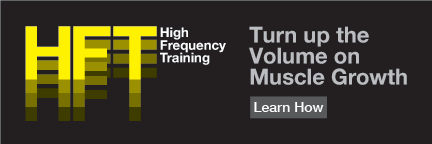Here are two questions I recently received that I thought would be a good fit for today’s blog:
Q: Chad, you have written that it’s possible to gain muscle on a 16-hour fast/8-hour eating phase. But to gain muscle you need enough calories, protein and carbs. Can the body make use of that much protein eaten in such a short amount of time? I heard that the body can only use 20-30 grams of protein and the rest will be stored as fat. – Andreas
CW: First off, the research that showed 20 grams of protein was sufficient to achieve peak levels of protein synthesis has caused an overreaction. While it might be true that 20 grams is no better than 40 grams for triggering protein synthesis, there are certainly other reasons to eat protein such as: increased thermogenesis, higher IGF-1, and a positive nitrogen balance, just to name a few. There’s no reputable research to support the idea that eating more than 20 grams of protein will cause fat gain.
Now, I’m certainly no fan of high protein diets. I think one gram per pound of lean body mass is probably the most anyone needs, unless we’re talking about an extreme endurance athlete. The rest of the calories should come from a combination of healthy fats, vegetables, and natural carb sources such as rice, potatoes and fruits. Eight hours is plenty of time to get in a day’s worth of nutrition, especially when you accept that the formulas for daily calories and protein are antiquated.
With that in mind, the most effective approach I’ve found for building muscle on a 16:8 ratio of fasting and feeding looks like this:
1. Don’t train on an empty stomach: Fasted cardio has its place, but fasted weight training definitely doesn’t when muscle growth is the goal. You should ingest protein and carbohydrates before any weight training to stimulate protein synthesis and provide glycogen to fuel muscle contractions.
Therefore, start the 8-hour eating phase with a meal. It can be a real-food meal such as lean protein and rice, or it could be liquid nutrition such as a high-quality whey and a piece of fruit or organic tart cherry juice since it has been shown to reduce muscle soreness. If you eat real food you might want to wait an hour before you train to allow for digestion. The protein/fruit combination is less stressful on your gut so you can train as early as 15 minutes later.
So break your fast, then train within an hour. I’ve found no real advantage to starting the 8-hour feeding phase later in the day, so if it better suits your schedule to do the feeding phase from, say, 10am-6pm, then go for it.
2. Eat within an hour after your workout: The old notion that there’s a special one-hour “window” post-workout hasn’t held up in research or practice. However, it’s important to get in sufficient calories to support muscle growth during the 8-hour phase. Therefore, if you eat within an hour after your workout you’ll be doing everything possible to ramp up your metabolism and support protein synthesis for the rest of the feeding phase.
If you broke the fast with real-food, this is a good time to consume whey protein and fruit. And if you broke the fast with whey/fruit, I recommend a real-food meal within an hour after your workout. However, consuming regular food at both times works great, too.
3. Eat when you’re hungry: Once you break the fast, train within an hour, and then eat again within an hour, the rest is pretty simple: eat when you’re hungry. Don’t worry about meeting a specific caloric requirement each day. If your body is hungry and needs food it’ll let you know. Just don’t feed it crap.
Q: Chad, I’m getting married in 6 weeks on the beach in Jamaica and I need to look my best. I want to start doing push-ups and pull-ups every day to improve my upper body. I tried this years ago and it worked wonders, then I tried it again and did too much and burnt out. What exactly should I do? – Mark
CW: The biggest mistake most people make with High Frequency Training (HFT) is that they do too much, too soon. It doesn’t take a lot of extra work to trigger muscle growth, provided you already have a solid weight training plan in place, such as three full-body workouts each week.
The pull-up/push-up combo is definitely a big hit with guys, but it’s important to do every rep with perfect form, and start with the correct volume. Here are the key technique points for each exercise. Remember, HFT protocols require perfect form or else you’ll run into joint problems very quickly:
Pull-up
- Do the pull-ups from rings, or with your palms facing each other (hammer grip) since it’s the least stressful shoulder position. If possible, fatten the grip with Fat Gripz to minimize elbow stress and achieve more biceps/forearm development.
- Start from a full hang with the arms straight. Stay out of the “turtle” position where your traps are shrugged up to your ears.
- Pull yourself just high enough so your chin clears the knuckles. There’s no reason to pull your body any higher since it causes anterior glide in the shoulder joints, and this can often lead to irritation.
Push-up
- Keep your chin tucked (make a double-chin) throughout each set. This will go a long way toward minimizing stress in the neck muscles that, in turn, can irritate the shoulders and shorten the pecs.
- Fingers should be spread wide with the middle finger pointed straight ahead to optimize neural drive.
- Attempt to “pull” your hands together as you push up to increase neural drive to the pecs. Your hands won’t actually move, but you’ll get a helluva lot more stimulation to the chest muscles. Slow down the reps as much as needed to feel the pecs firing.
- Keep the body in a straight line from neck to ankles – never let your stomach sag toward the ground.
Now, the ideal starting volume should be individualized. For the pull-up, your first day of a HFT plan should start with a total number of reps that equals twice your max reps for one set. So if you can do 11 perfect pull-ups, start with 22 total reps on day 1. Spread those reps throughout the day as much as possible. Then, add a rep each day.
For the push-up, most guys use a variation that’s too easy, therefore, their muscle-building results end up being subpar. This is why it’s essential to read the technique guidelines I gave above. I’ve seen many guys who could do 30 “normal” push-ups fall to 11 or 12 when they adhere to those points. The number of push-ups you do each day is twice the number of pull-ups. In this example, the guy would start with 44 total push-ups, spread throughout the day, and then add a rep each day.
Finally, take one day off per week from the pull-up/push-up HFT combo.
Stay Focused,
CW


